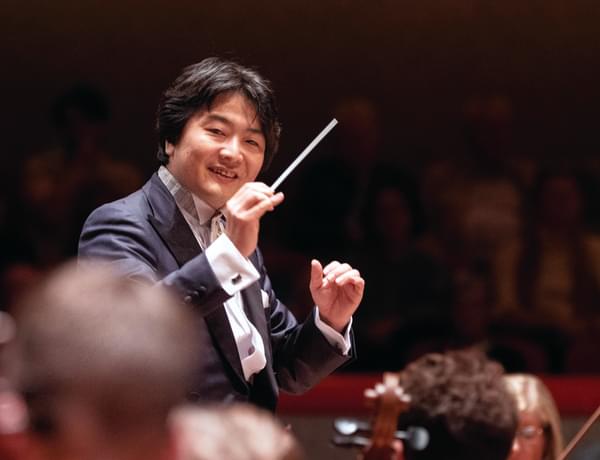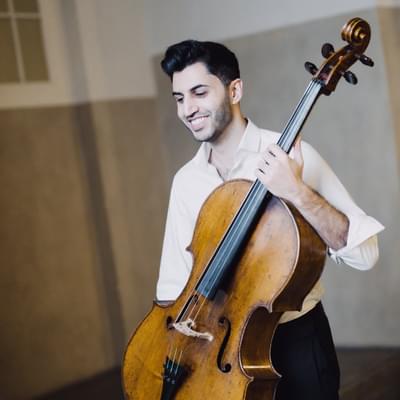Kazuki conducts Joy

Full programme
- Berlioz, Roman Carnival (9mins)
- Fauré, Elegy for Cello & Orchestra (7mins)
- Saint-Saëns, Cello Concerto No.1 (20mins)
- Bernstein, Symphonic Dances from West Side Story (23mins)
- Ravel, La Valse (13mins)
Performers

Kazuki Yamada
Conductor
Kian Soltani
Cello
Introduction
This will be my first time playing with the City of Birmingham Symphony Orchestra which is always very exciting. I’ve only ever been to Birmingham once and I’m really looking forward to spending some more time in the city!
The pieces I am playing in this concert are very familiar to me. Saint-Saëns’ Cello Concerto was one of the first cello concertos I learnt as a teenager – the language of the music is so clear and understandable; it’s quintessentially Romantic and a wonderful piece for young musicians to discover. Over time, however, such a masterful work requires maturity in its approach – I’ve played it many, many times during my career so far and naturally, how I play this concerto has changed a lot from when I first learnt it.
A particular highlight for me in this concerto is the second, slow movement. It is very charming, almost like a little ballet; the orchestra are like the dancers whilst the cello sings the melodic line on top. The concerto as a whole moves very freely, with little interruption between the movements – an idea that was very progressive at its time.
Fauré's Elegy for Cello and Orchestra has been one of my favourites from the beginning – it might be one of the most beautiful pieces we have in our repertoire as cellists. An elegy is a piece written for somebody’s death, often someone close to you, which obviously gives it a very deep meaning just by itself and paired with the music that encompasses it, the piece becomes something so beautifully written. The piece builds from the very start, beginning with one melody that repeats throughout until it is played for one final time at the end in a very climactic, loud reprise. The melody at this point is very high in the cello and it is my favourite moment of this piece - building up to that climax is just electrifying!
It will also be my first time working with Kazuki and after this concert, we continue to work together on the CBSO European tour. I absolutely love to tour - normally you get to play a programme only once or twice so to get to play this programme multiple times with the orchestra will be really exciting. The more and more comfortable the soloist and the orchestra become with one another, the more wonderful the music-making becomes, so I am sure it will be a special tour.
Kian Soltani
Cello
Programme Notes
You’ll have a hard time keeping to your seat in this programme of dances and fantastical scenes led by Kazuki Yamada. After capering at the Roman Carnival with Berlioz, pause for breath in Fauré’s stunning Elegy, featuring the mesmeric Kian Soltani, before the cello has a major workout in Saint-Saën’s blazing Cello Concerto. Then it’s no holds barred for Bernstein's riotous Symphonic Dances before Ravel leads us in an elegant Valse.
Roman Carnival
Hector Berlioz (1803-1869)
In 1838 Berlioz composed Benvenuto Cellini, an opera based (very loosely) on the life of a Florentine sculptor. It was, sadly, an almighty flop. According to the composer, it was ‘hissed with admirable energy and unanimity’ at its premiere and Berlioz found the wholesale rejection of his opera similar to being ‘stretched on the rack’. He had, optimistically, composed a new second-act overture for what he believed would be the likely revival of Benvenuto; when that did not happen, he presented it as the concert overture Roman Carnival in 1844, recycling several melodies from the opera, including the beautiful ‘love’ theme adapted for the cor anglais. As Herbert Glass once put it, ‘Berlioz, like the better French chefs, never threw anything away’.
The Overture begins with an attention-grabbing burst before making space for the cor anglais theme. After reaching a romantic peak, a sparkling whirl from the woodwind reintroduces a faster pace, and a breathless sense of anticipation: this is the ‘carnival’ section from the opera. It builds dramatically, with crashing interjections from the full percussion section, only to abruptly reduce to a woodwind whisper. This is followed by a feverish fugue, a rising figure played by different instruments in turn. The Overture continues in this spirited vein, threatening to come completely off the rails by the end.
Élégie for Cello & Orchestra
Gabriel Fauré (1845-1924)
Fauré planned to compose a sonata for cello and piano, and embarked on what would have been its slow movement in 1880. Yet nothing further came forth, so – pragmatically – Fauré renamed the standalone movement Élégie and it was publicly premiered in 1883. Its instant and enduring popularity led Fauré to orchestrate the piano accompaniment in 1896, giving the 8-minute piece the character of a tiny concerto. The opening music is sombre and elegiac indeed, with a slow pulsing in the orchestra against which the cello delivers a lengthy, melancholy melody. A middle section blossoms into a contrasting major key, still with the same slow pulse but given a sense of forward movement by rapid notes in the upper strings. There is a cadenza-like passage, with the cello bristling virtuosically up and down a series of scales, before the return of the opening melody. The sombre effect of the final bars is emphasised by the cello sinking to its lowest possible note – C – at the very end; an open string, with no potential to be warmed by vibrato.
Cello Concerto no.1
Camille Saint-Saëns (1835-1921)
Saint-Saëns was a kind of ‘musical grandfather’ to the French composers of the twentieth century. Fauré was Saint-Saëns’ pupil, and later become the teacher of Ravel. Ravel in particular greatly admired Saint-Saëns’ elegance and adherence to classical forms, both of which are in evidence in this beautifully-constructed and highly melodic Cello Concerto no.1 composed in 1872.
The Concerto begins with a bang: a single, explosive chord from the orchestra, heralding the cello’s first, and most important theme. This melody, formed from triplets, appears in various guises and in each movement of the Concerto. The work as a whole has a propulsive momentum and, unlike most concertos, each movement blends into the next without a break. Within its bustling energy there are moments of great lyricism, such as a theme heard after about 90 seconds in the first movement. But generally the tempo markings are brisk, with lively, scurrying figures shared between soloist and orchestra. There is more repose at the start of the second section where we hear an elegant, 18th-century style minuet, intertwining with a sumptuous solo from the cello (the expressive quality of the melody here looks forward to Saint-Saëns’ most famous tune for cello: ‘The Swan’ from his Carnival of the Animals, composed some 15 years later). The final section is characterised by great romantic drama, and some hair-raisingly difficult writing for the cello (the concerto is considered to be one of the hardest in the repertoire). Saint-Saëns’ seemingly boundless melodic imagination can be heard in the profusion of themes, until the Concerto concludes – breathlessly – with a race to the finish line.
Symphonic Dances from West Side Story
Leonard Bernstein (1918-1990)
Bernstein’s most famous work, West Side Story, was an instant success at its premiere in 1957. Its popularity and perpetual rediscovery by subsequent generations is perhaps down to its clever, punchy updating of Romeo and Juliet. But mainly, arguably, it is due to Bernstein’s irresistible score: fiercely rhythmic, tenderly lyrical and – as the composer himself said looking back in 1984 – ‘so funky’.
The Symphonic Dances use nine numbers from the show, mainly those concerned with the gang rivalry rather than the romance between Tony and Maria (although the melody of the song ‘Maria’ is the same as the opening three notes of the ‘Prologue’, and features similarly in the ‘Cha-cha’ movement). The ‘Prologue’ is full of snap and crackle as the two gangs attempt to seize territory from each other, followed by a wistful counterpoint in ‘Somewhere’ which imagines a world away from all this. The central movements include the famous ‘Mambo’, the vigorous - bordering on violent - dance-off at the gym. After the more delicate ‘Cha-cha’ Bernstein demonstrates his composer’s chops in ‘Cool’, an elaborate fugue in a slinky jazz style. The ‘Rumble’ is suitably melodramatic, while the final movement is a devastating rendering of Maria’s song ‘I have a love’, concluding with a tolling bass and a chillingly unresolved final note.
La Valse
Maurice Ravel (1875-1937)
Ravel’s La Valse was composed in 1919-20 and initially conceived as a ballet. It is subtitled ‘poème chorégraphique pour orchestre’, and Ravel wrote the following ‘programme’ for the piece in the score:
Through whirling clouds, waltzing couples may be faintly distinguished.
"The clouds gradually scatter: one sees… an immense hall peopled with a whirling crowd. The scene is gradually illuminated. The light of the chandeliers bursts forth... Set in an imperial court, about 1855."
While it was eventually choreographed in the late 1920s, it is largely known today as a purely orchestral piece, and one with an entirely musical ‘programme’. Composer George Benjamin once wrote that Ravel’s ‘La valse is a piece with one central idea, which it grips with the tenaciousness of a dog with a bone’. For Benjamin, the piece is a kind of biography of the waltz – the ‘central idea’ of the piece – from its birth, through its vivacious life, to decay and ultimately death. Some have interpreted the almost diabolical breakdown of rhythm in the closing bars as a comment on the destruction of genteel society after World War I. Ravel, however, refused to accept this interpretation, suggesting that his locating the ‘scenario’ in 1855 disproved it in any case.
However one interprets it, La Valse has a cumulative, propulsive power, and is a magnificent illustration of Ravel’s genius at orchestration. The opening bars, for example, describe the woozy, drowsy birth of the waltz against a backdrop of shimmers, growls, and insistent pulsing. Hints at a 3-time beat gradually emerge via low-lying woodwind and muted strings, along with flutter-tongued flutes and muted horns, all sounding as if they are trying to wake up. Recognisable waltz-style melodies finally appear, in fact several in sequence, though some are curiously off-kilter, rather than necessarily easy to dance to. After this ‘suite’ of waltzes, the music is recapped, but altered, abbreviated, or with its instrumentation switched around. The derailment begins around two minutes before the end, with the waltz becoming lost under rhythmic displacement, and thumps and slaps from the percussion. The final bars are simply wild: Ravel’s imaginary ‘imperial court’ is shattered beyond recognition.
© Lucy Walker